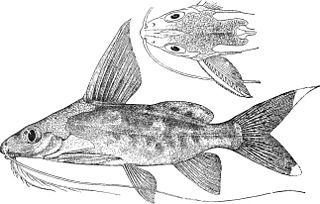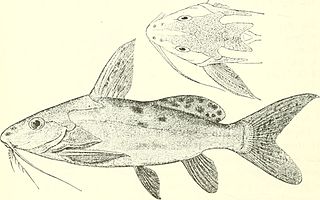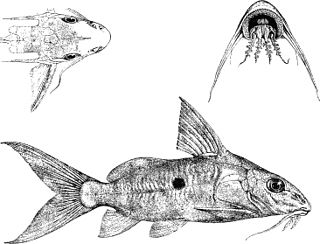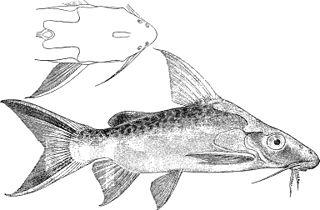
Synodontis acanthomias is a species of upside-down catfish native to the Congo Basin of Cameroon, the Central African Republic, the Democratic Republic of the Congo and the Republic of the Congo. It was originally discovered by George Albert Boulenger in 1899 in Boma, in the Democratic Republic of the Congo. The original specimen resides in the Natural History Museum in London. The species Synodontis pfefferi, described by Franz Steindachner in 1912 was found to be the same species. The specific name "acanthomias" means "very spiny", a reference to spines found on the side of the fish's body.

Synodontis alberti, the bigeye squeaker, Albert's syno, bigspotted squeaker, or high-fin synodontis, is a species of upside-down catfish native to the Congo Basin of Cameroon, the Democratic Republic of the Congo and the Republic of the Congo. It was originally described in 1891 by Belgian ichthyologist Louise Schilthuis after its discovery in the Malebo Pool of the Congo River.
Synodontis albolineatus, known as the mustard catfish, or the mustard squeaker, is a species of upside-down catfish native to Gabon and Cameroon, where it occurs in the Ntem and Ivindo rivers. It was first described by French zoologist Jacques Pellegrin in 1924, based upon a holotype discovered in the Djoua River at Madjingo, Gabon. The holotype specimen resides in the Musee National d' Histoire Naturelle de Paris. The specific name "albolineatus" is a composite from the Latin word albus for "white" and the Latin word linea for "line", which refers to the white midlateral stripe of the species.
Synodontis congicus is a species of upside-down catfish native to the Democratic Republic of the Congo and the Republic of the Congo where it occurs in the upper and middle Congo Basin. It was first described by Belgian ichthyologist Max Poll in 1971. The first specimen was found near the town of Gangala-na-Bodio, Democratic Republic of the Congo, in the Dungu River. The meaning of the specific name "congicus" is "From the Congo".

Synodontis courteti is a species of upside-down catfish that is native to the countries of the Niger and Chad Basins. It has been recorded in Cameroon, Chad, Ghana, Guinea, Mali, Niger, and Nigeria. It was first described by French zoologist Jacques Pellegrin in 1906, from specimens collected in the Chari River, Chad. The species name courteti is named after M. Courtet, member of the "Mission Chari-Lac Chad".
Synodontis flavitaeniatus, known as the orangestriped squeaker, the chocolatestriped squeaker, the yellowstriped squeaker, and the pyjama Syno, is a species of upside-down catfish native to the Democratic Republic of the Congo and the Republic of the Congo where it is found in the lower and central Congo Basin. It was first described by Belgian-British zoologist George Albert Boulenger in 1919. The holotype was collected from the Ruki River at Eala, in the Democratic Republic of the Congo. The meaning of the specific name "flavitaeniatus" is "yellow stripes".

Synodontis greshoffi is a species of upside-down catfish native to the Congo Basin of Cameroon, the Democratic Republic of the Congo and the Republic of the Congo. It was first collected by M.A. Greshoff in Pool Malebo on the upper Congo River, and the species was named for him by the author of the first paper written about the species, Belgian ichthyologist Louise Schilthuis, in 1891.

Synodontis haugi, known as the black synodontis, is a species of upside-down catfish native to Gabon where it is found in the Ogowe River basin. It was first collected by M.E. Haug and described by French zoologist Jacques Pellegrin in 1906, based upon a holotype discovered in the Ogooué River, near Ngomo, Gabon. The specific name "huagi" is a tribute to the original collector of the species.

Synodontis longirostris, known as the eyespot synodontis, is a species of upside-down catfish that is native to the Democratic Republic of the Congo where it occurs in the Congo Basin. It was first described by British-Belgian zoologist George Albert Boulenger in 1902, from specimens obtained in the Ubangi River at Banzyville. The species name longirostris comes from the Latin word longus, meaning "long", and the Latin word rostrum, meaning snout, referring to the long snout on this species.

Synodontis notatus, known as the onespot squeaker, the one-spot synodontis, or the domino syno, is a species of upside-down catfish native to the Congo Basin of the Democratic Republic of the Congo, and the Republic of the Congo. It was first described by French zoologist Léon Vaillant in 1893. The specific name "notatus" comes from the Latin word for "marked", as with a spot.

Synodontis nummifer, known as the two spot synodontis, is a species of upside-down catfish native to the Congo Basin of Cameroon, the Democratic Republic of the Congo and the Republic of the Congo. It was first described by the Belgian-British zoologist George Albert Boulenger in 1899, based upon a holotype discovered in Léopoldville, Belgian Congo. The specific name "nummifer" comes from the Latin for "to bear a coin", which refers to the large spots on its sides.

Synodontis ocellifer, known as the ocellated synodontis, is a species of upside-down catfish native to the rivers of northern and western Africa. It has been reported in 10 countries, including Burkina Faso, Cameroon, Chad, Gambia, Ghana, Guinea, Mali, Niger, Nigeria, and Senegal. It was first described by Belgian-British zoologist George Albert Boulenger in 1900, from specimens collected in Kunchow Creek, in Gambia. The species name ocellifer comes from the Latin word ocellus, meaning "eye", and the Latin word ifer, meaning "to carry", which refers to the black spots, possibly with white centers found on the sides.
Synodontis pardalis is a species of upside-down catfish that is endemic to Cameroon where it occurs in the Dja River drainage. It was first described by British-Belgian zoologist George Albert Boulenger in 1908, from specimens collected in the Dja River in southern Cameroon. The species name pardalis is derived from the Greek word pardalis, which means "leopard", which refers to the spotted pattern on the fish.

Synodontis pleurops, known as the Congo squeaker, the bigeye squeaker, or the bug eyed synodontis, is a species of upside-down catfish native to the upper Congo Basin of Cameroon, the Democratic Republic of the Congo and the Republic of the Congo. It was first described by the Belgian-British zoologist George Albert Boulenger in 1899, based upon a holotype discovered at the Boyoma Falls, in the Democratic Republic of the Congo.
Synodontis polyodon is a species of upside-down catfish native to Gabon where it occurs in the Ogowe River basin. It was first described by French zoologist Léon Vaillant in 1895, based upon a holotype discovered in the Ogooué River, near Adouma, Gabon. The specific name "polyodon" comes from the Greek words poly, meaning "many" and odon, meaning "tooth", referring to the many teeth in this species.

Synodontis resupinatus is a species of upside-down catfish that is native to the Niger basin and the Bénoué River of Cameroon, Mali, and Nigeria. It was first described by British-Belgian zoologist George Albert Boulenger in 1904, from specimens obtained near Lokoja, Nigeria.
Synodontis schoutedeni, known as the yellow marbled Synodontis, is a species of upside-down catfish native to the Congo Basin of the Democratic Republic of the Congo and the Republic of the Congo. It was first described by Belgian ichthyologist Lore Rose David in 1936, based upon a holotype discovered in Basongo, in what is now the Democratic Republic of the Congo. The specific name "schoutedeni" is named after the Belgian zoologist Henri Schouteden.

Synodontis smiti, known as the longtail Synodontis, or Smit's Synodontis, is a species of upside-down catfish that is endemic to the Democratic Republic of the Congo where it is found in the middle and upper Congo Basin. It was first described by British-Belgian zoologist George Albert Boulenger in 1902, from specimens obtained in the Ubangi River at Banzyville. The species name smiti is named for Pierre Jacques Smit, who illustrated the plates in Boulenger's works.

Synodontis woosnami, known as the Upper Zambezi squeaker, or bubblebarb squeaker, is a species of upside-down catfish that is native to Angola, Botswana, Namibia, Zambia and Zimbabwe where it is found in the upper Zambezi and Okavango River basins and the Cunene River. It was first described by British-Belgian zoologist George Albert Boulenger in 1911, from a specimen collected in the Okavango River in the Lake Ngami district of Botswana. The species name woosnami is derived from R. B. Woosnam, the collector of the first specimen.
Synodontis woleuensis is a species of upside-down catfish native to Equatorial Guinea and Gabon. It was first described in 2008 by American zoologists John P. Friel and John P. Sullivan. The original holotypes were collected in the Woleu-Ntem Province, Gabon. The specific name "woleuensis" is derived from the Woleu River, where the specimens were originally collected.














